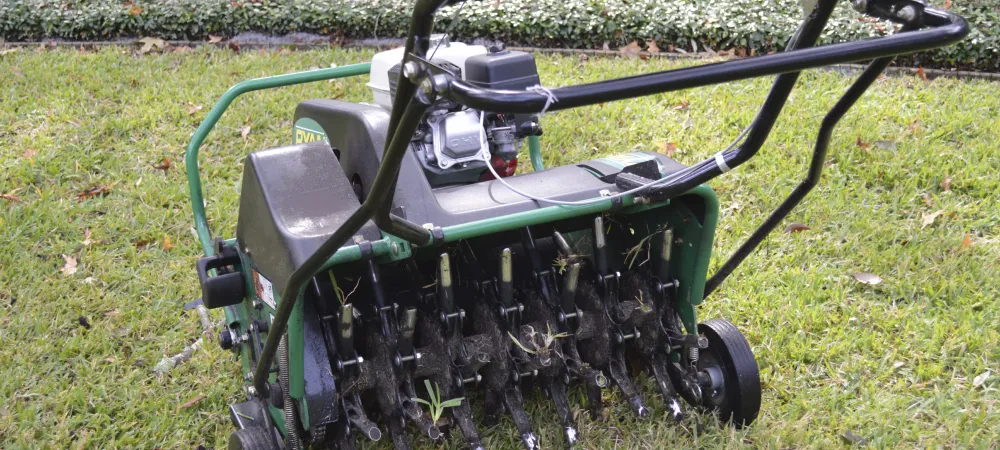When to Aerate your Lawn

What is Compacted Soil?
Compacted soil is essentially a build-up of thatch, or layer of grass clippings and organic matter that form a barrier at the base of your turf. It reduces the rate of both water infiltration and drainage preventing nutrients and water from getting to and from your grassroots. This will cause your grass to become malnourished and dehydrated. Weakening, over time, it will die.
Signs You Have Compacted Soil:
- Spongy grass
- Water runs off or pools in areas of your yard.
- Bare or patchy areas of grass
- Stunted growth of plants
- Hard soil – Test your soil by sticking a screwdriver into the ground. If it’s dry and does not easily penetrate, your soil is probably compacted.
The best way to combat compacted soil is through a process called core aeration.
What Is Aeration?
Aeration, also known as core aeration or traditional aeration, uses a tool called an aerator to punch out tiny plugs of soil from your lawn. Don’t worry – these plugs are extremely small and won’t ruin the look of your lawn. All these holes will break up any compacted soil and accumulated thatch build-up. These holes also make it possible for oxygen, water, sunlight, and nutrients to make their way to the root zone of the grass. As your lawn prepares for the cooler season, it’s crucial that you give it all the help you can and aeration in the fall is perhaps the biggest leg up.
What Is Overseeding
Overseeding is the yin to aeration’s yang. They go together so often because they both help restore your lawn, and they compliment each other. As we already discussed, aeration opens up your lawn and creates hundreds of tiny holes. If your lawn looks thin or has fully bare patches, these holes allow the overseeding process to have an advantage. Overseeding means distributing a high-quality grass seed blend over the surface of your lawn. If you choose to do this in conjunction with aeration, the holes will allow the fresh grass seed to settle into the soil rather than sitting on top of it. This will allow the new grass to establish more quickly. Now you may be wondering: wouldn’t it be better to put down fresh seeds in spring? Actually, the ideal time is fall. That’s because fall has warm days – not scorching hot – and cool nights, which means there’s plenty of moisture left in the soil. Fall is the last hurrah of your grass’s growing cycle before winter comes. So even though it may not seem like it, now is the ideal time to regreen your lawn with some fresh grass seed.
Furthermore, overseeding in the fall doesn’t interfere with weed control efforts. In spring, applying pre-emergent weed control is the best defense against weeds because it attacks them before they have a chance to sprout. Applying grass seed at this time can interfere with this. By seeding in fall, the grass won’t be tripping over its own feet, so to speak.
The Benefits of Overseeding Your Lawn
After aerating your lawn, it is primed and ready for overseeding. Overseeding introduces new types of grass seed to the existing turf with other grass strains. It’s many purposes include:
- To fill in any bare areas
- To create thicker grass and prevent weeds
- Thicker grass to prevent weeds
- Fend off pests, drought, and disease
- Enhance appearance and color
Fall Aeration = Fewer New Weeds
One of the downsides of aerating in the spring is that the aeration process might inadvertently kick up any weeds lurking in your lawn. Dormant weeds need LOTS of direct sunlight to germinate, and you might give them just that when aerating in spring. By aerating in fall, you avoid this problem because weeds are going dormant for the winter. Plus, just as the freshly opened soil will be receptive to new grass seed, it will also be receptive to weed control products.
Aerating In Fall Removes Thatch At Its Worst
Thatch is the layer of dead organic material that exists in all lawns. It’s comprised of things like dead grass clippings, leaves, flower petals, or even small bits of twigs and branches. Having thatch in your lawn doesn’t mean that you don’t take good care of it. It builds up naturally over time, and it’s present in every lawn. However, if it becomes too thick, it can suffocate your turfgrass. After all the intense growth of summer, thatch is at its thickest levels right now in early fall. If thatch is left on the lawn over winter, it can make for big problems in spring. When the start of the growing season kicks off, all that thatch will block out things like air, water, sunlight, and nutrients – in much the same way that compacted soil will. Plus, excess thatch can harbor pests and lawn diseases. Things like mold and mildew need an environment that is both cool and shady, and thatch fits the bill.
Aerating In Fall Slows Winter Compaction
Like thatch build-up, the soil will become compacted over time. If you have pets and/or children who frequently run across your lawn, compaction will likely happen at a faster rate. When soil is compacted, it means it’s too hard for roots to move easily through it. It also prevents the four key things all plants need to thrive: air, water, sunlight, and fertilizer. Now that summer is winding down, compaction, like thatch, will be at its worst. By aerating now, you will give your lawn a boost during the final stage of the growing season before it goes dormant in the winter.
Get Lawn Aeration Service From NuLeaf Lawn Care
For many years, the NuLeaf Lawn Care professionals have helped thousands of lawns across the Arlington area with compaction issues. Our aeration service will rescue your turfgrass from the clutches of compacted soil and excess thatch and give it a head start for next spring. Our experts are happy to answer any questions you may have! To learn more about this vital service, or schedule an appointment, give us a call at 703-688-8967 or leave us a message online here.
Don’t forget to check back next month for more helpful articles on our blog page. We cover different topics like lawn disease, best practices for pest control, balancing problem soil, and more!

